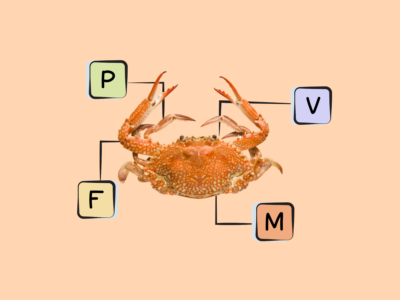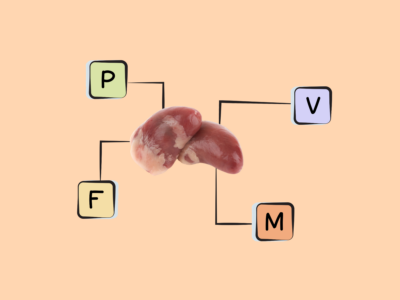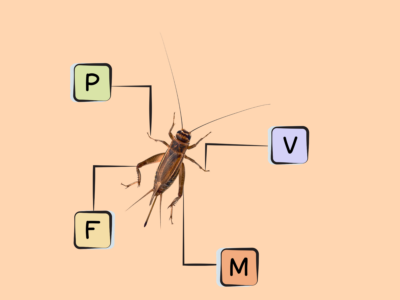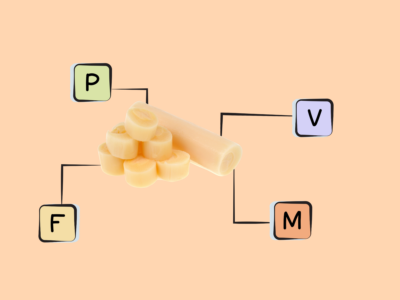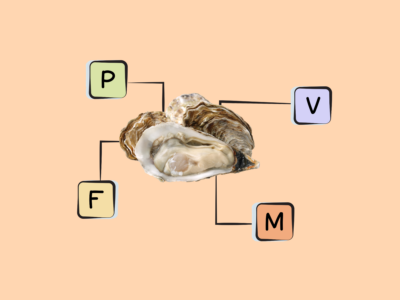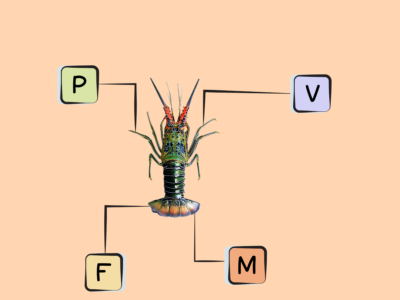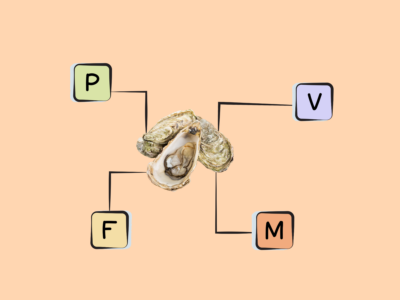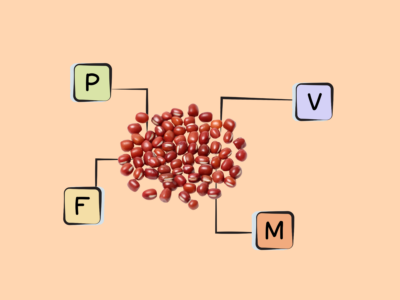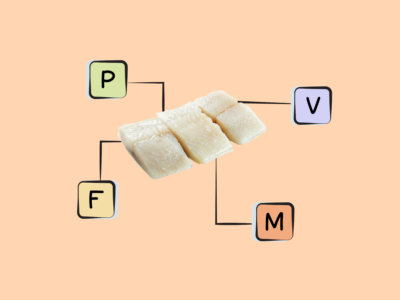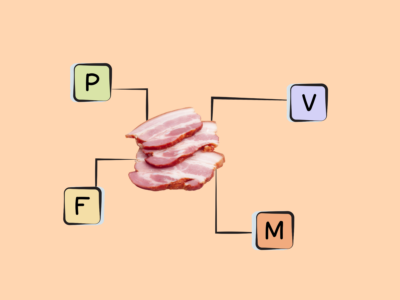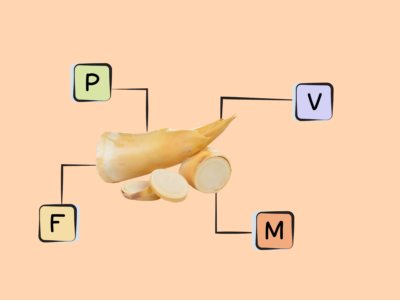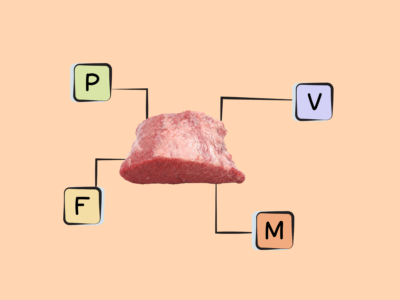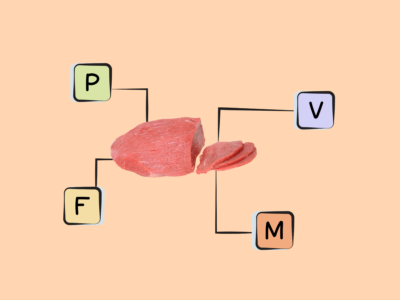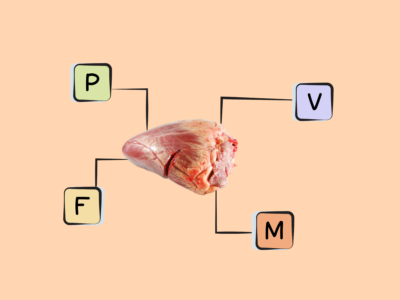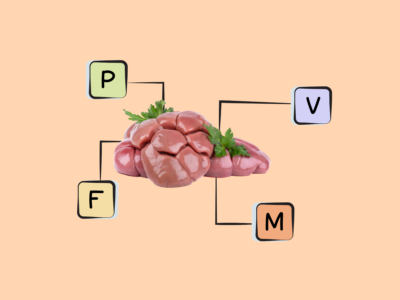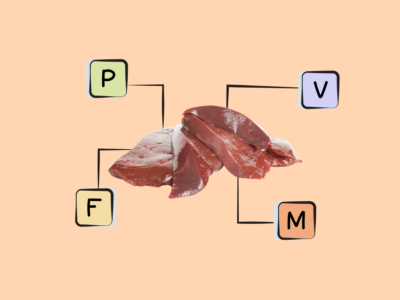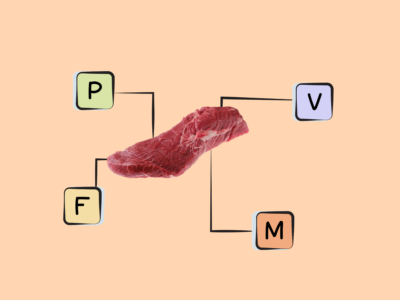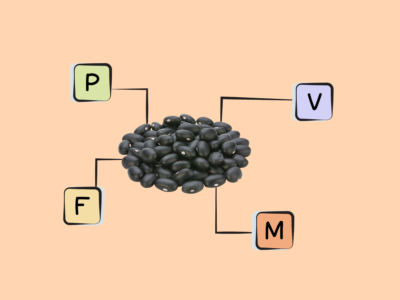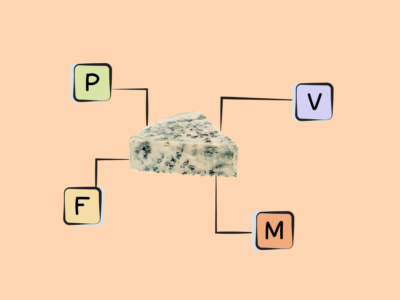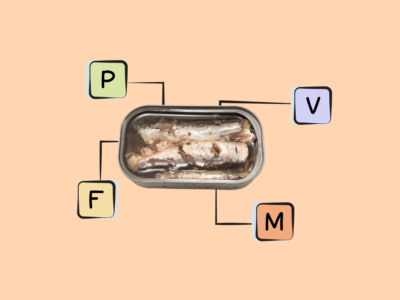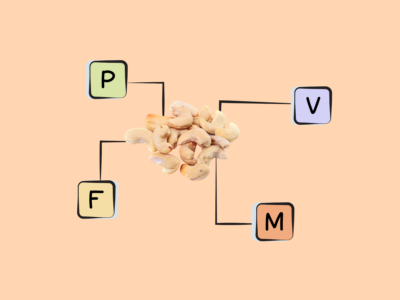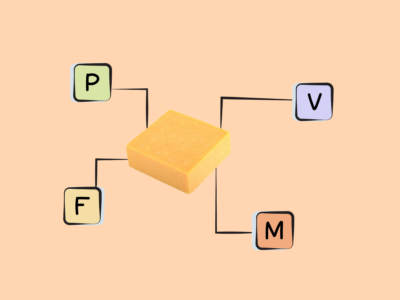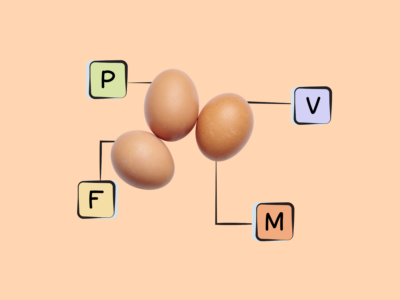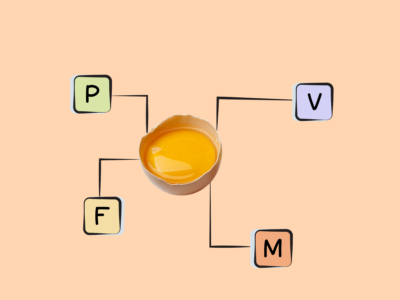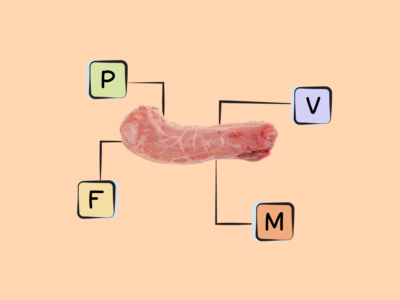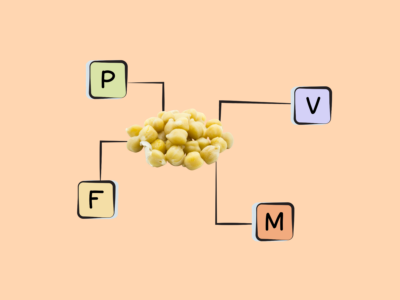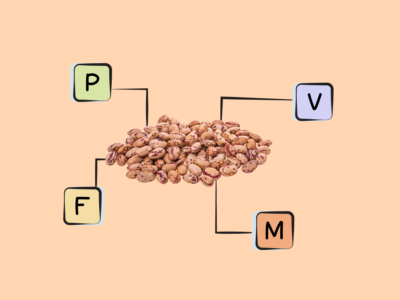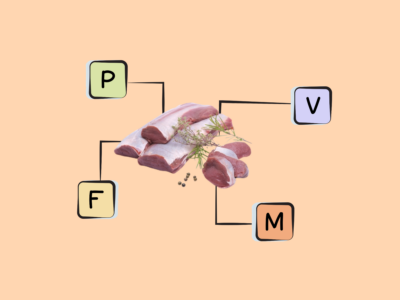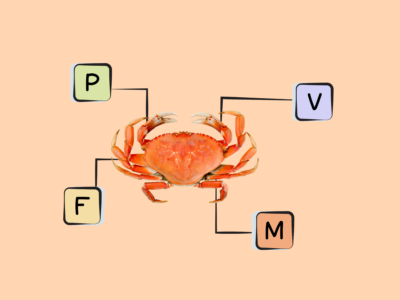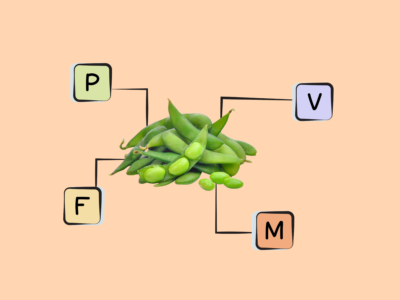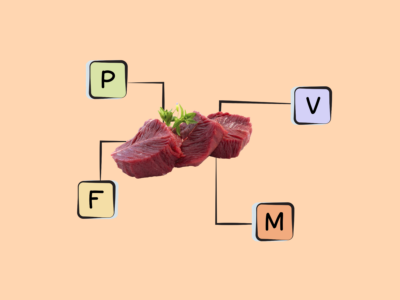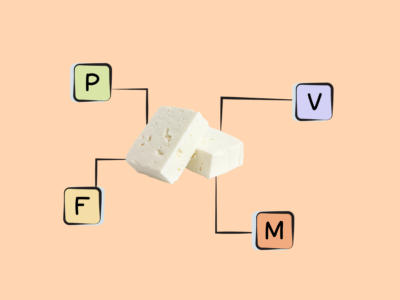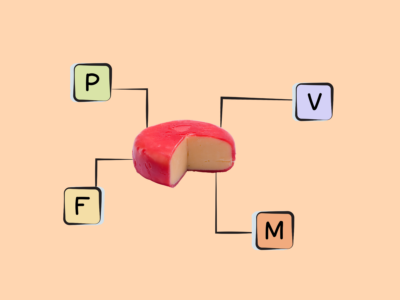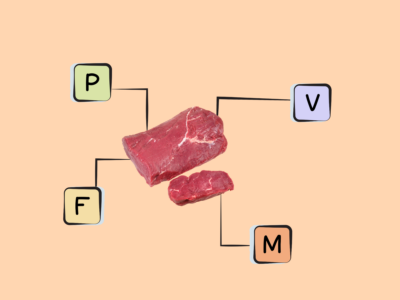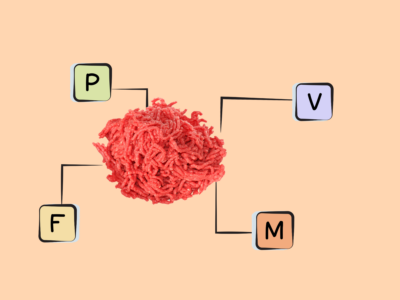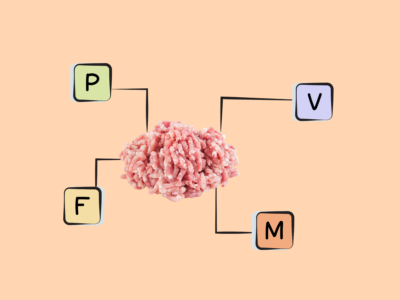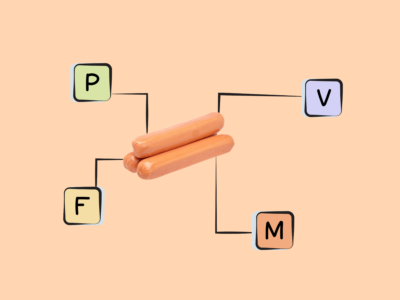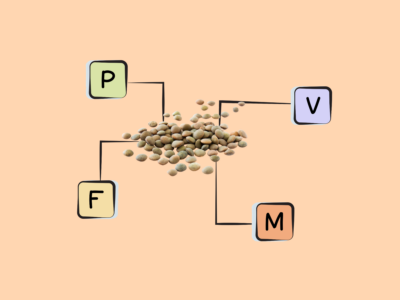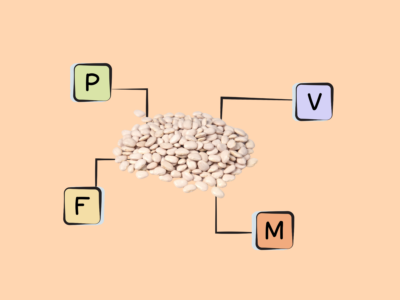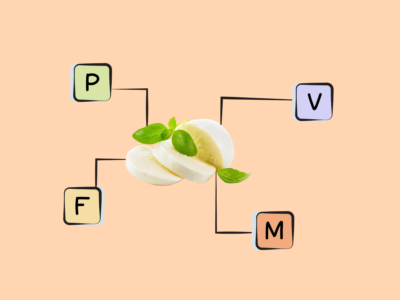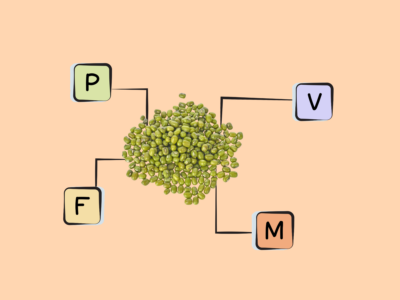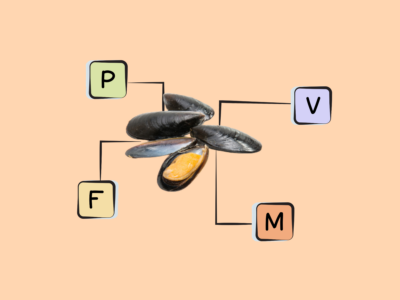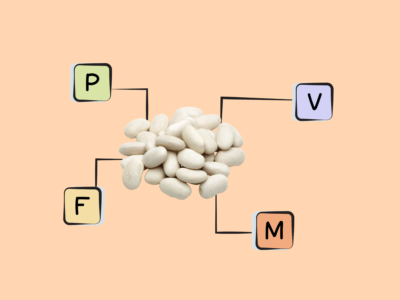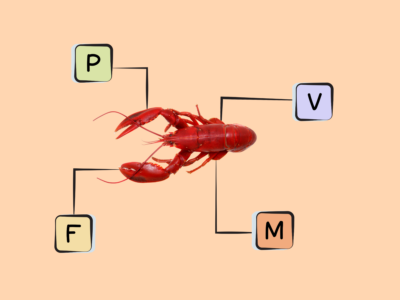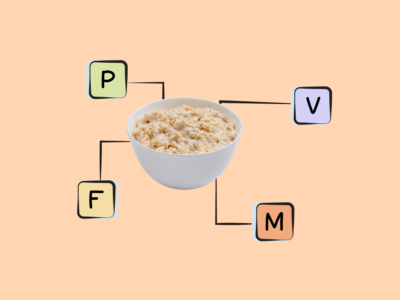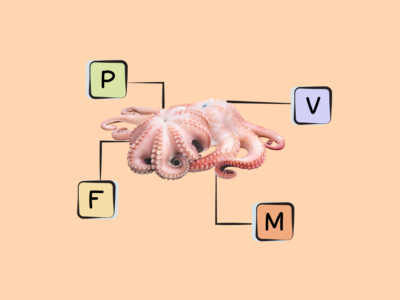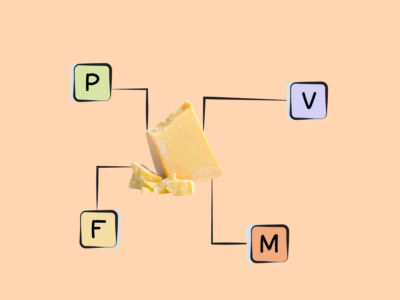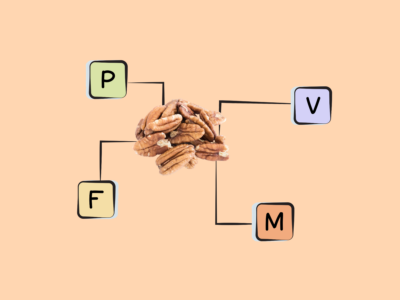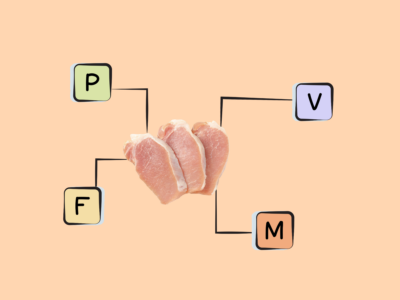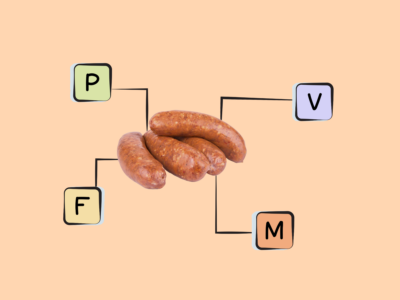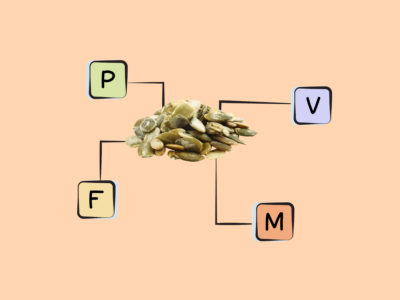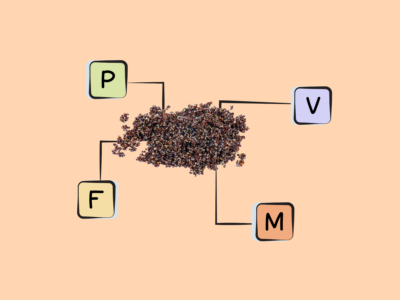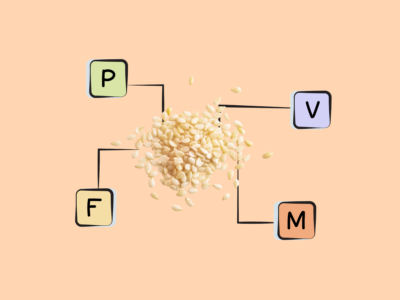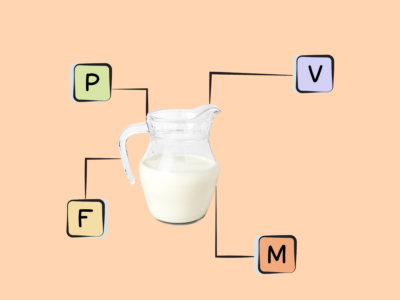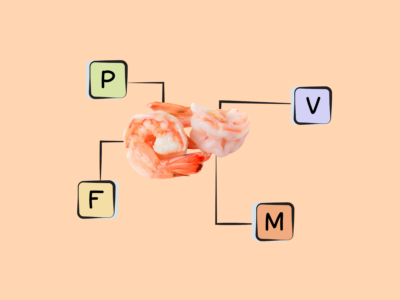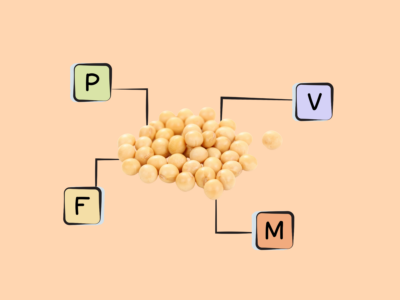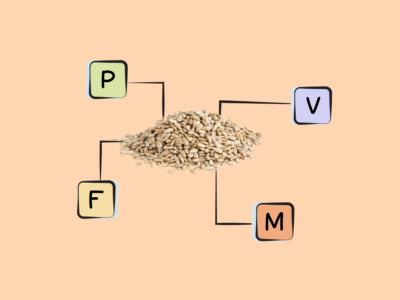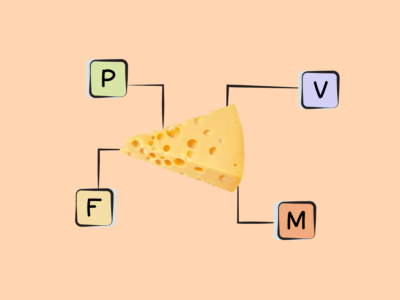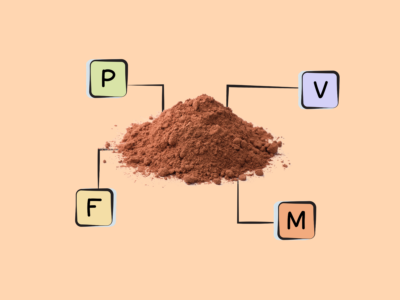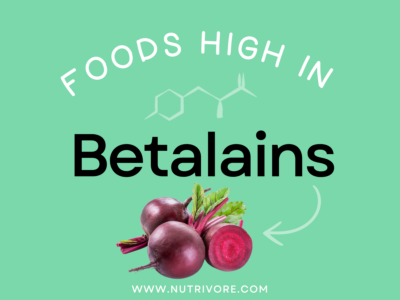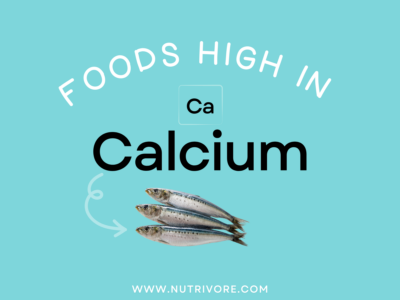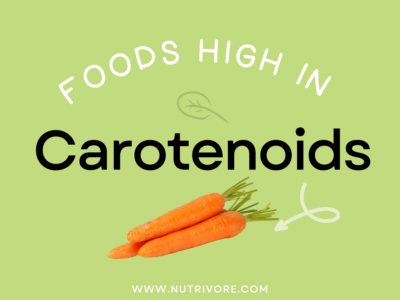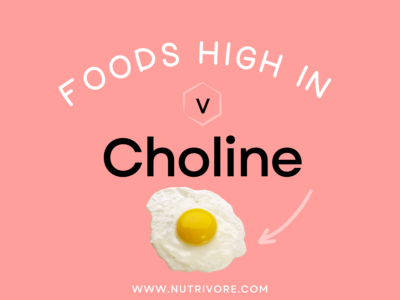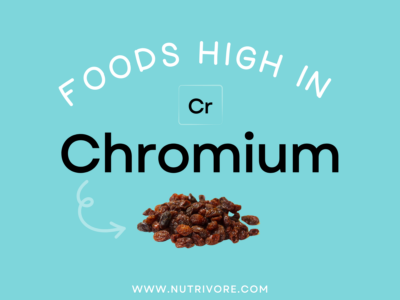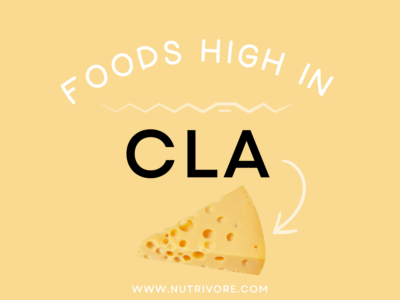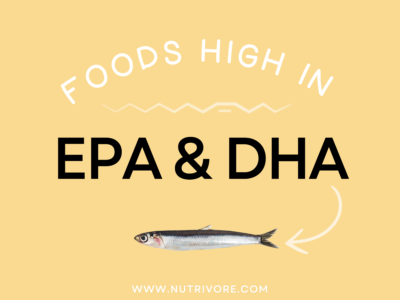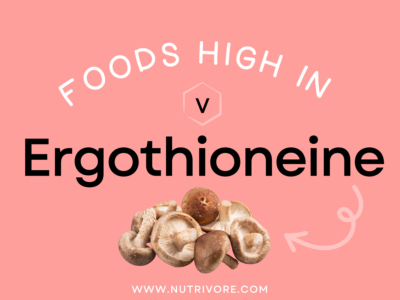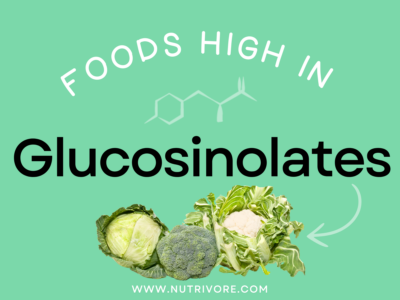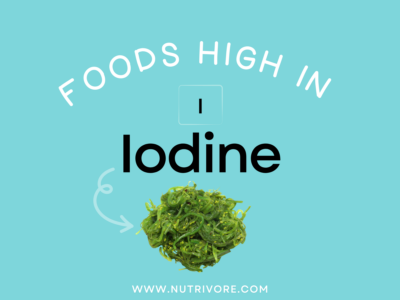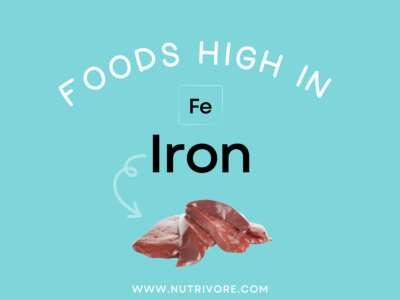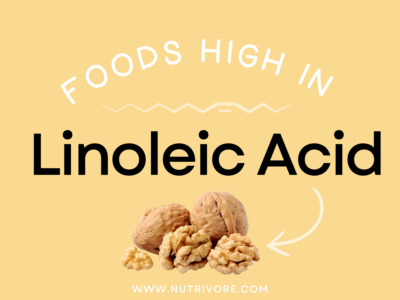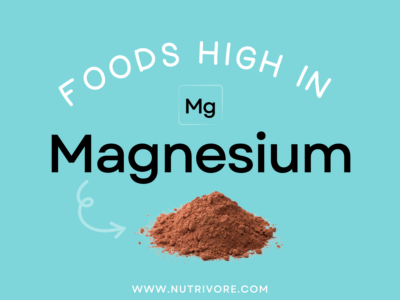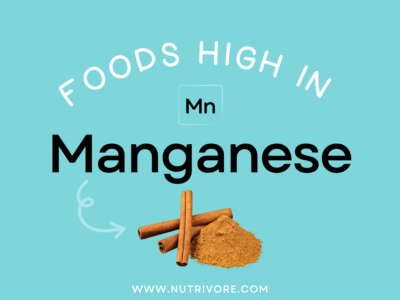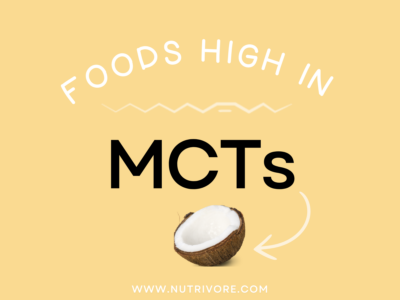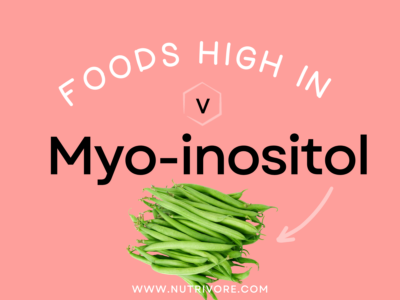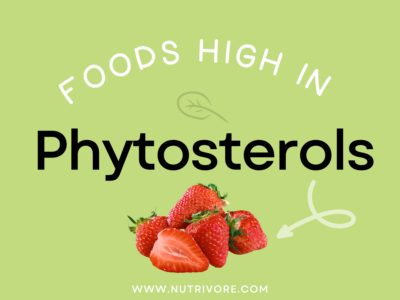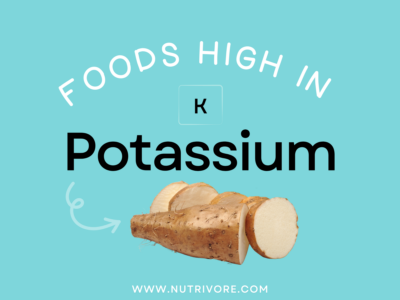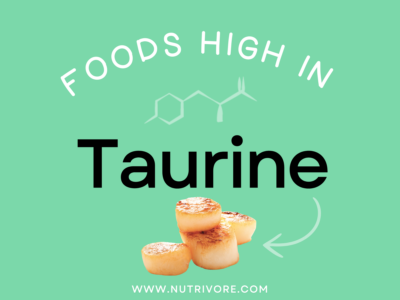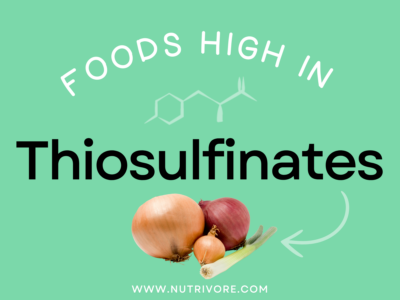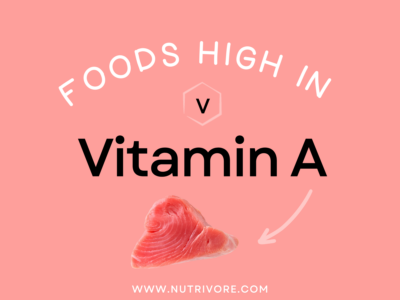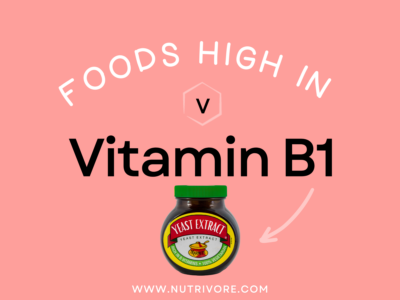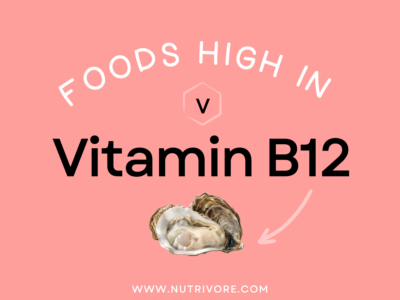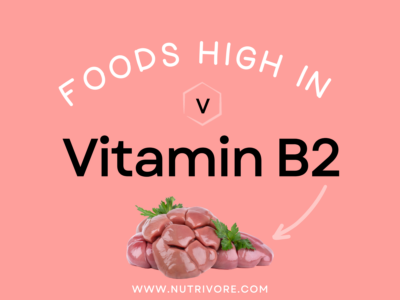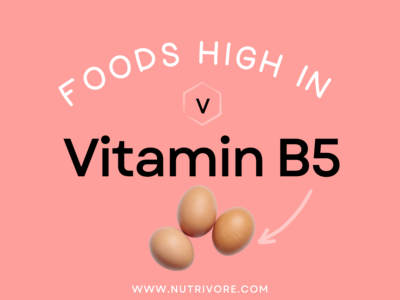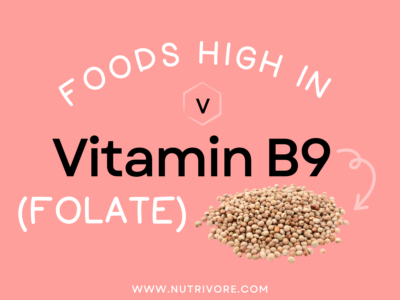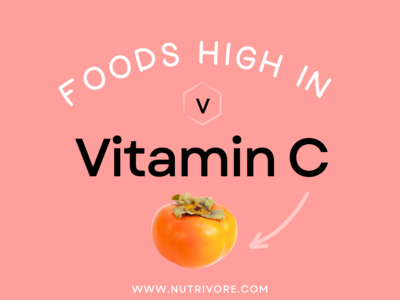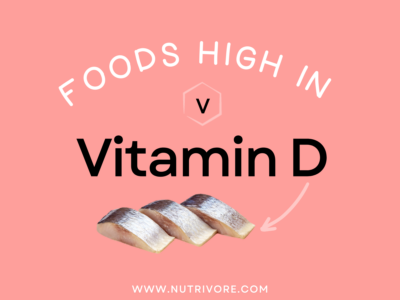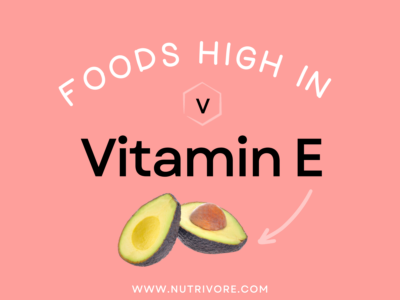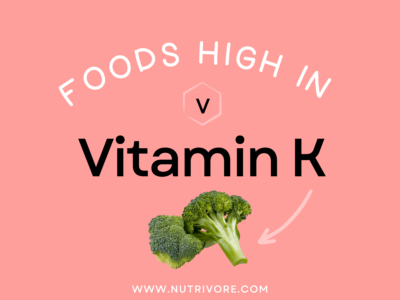Table of Contents[Hide][Show]
Top 5 Common Food Sources of Zinc
Looking to get more mg of zinc in your diet? Look no further! My team and I have crunched the numbers and did all the math to determine the top 5 common food sources of zinc, per serving. Aside from oysters, most food sources of zinc provide moderate amounts per serving, so it’s important to choose a variety of zinc rich foods and and sprinkle them throughout the day. Getting zinc from our diet through healthy eating is important since a large collection of studies show that getting nutrients from dietary supplements doesn’t improve health outcomes compared to getting nutrients from foods!
| Rank | Food | Nutrivore Score | Serving Size (Raw) | Zinc (mg/serving) | % Daily Value |
|---|---|---|---|---|---|
| 1 | Oysters, Average1 | 2759 | 4 oz / 115 g | 36.0 | 327 |
| 2 | Beef, Average2 | 293 | 3.5 oz / 100 g | 4.8 | 44 |
| 3 | Crab, Average3 | 1096 | 4 oz / 115 g | 4.8 | 43 |
| 4 | Soybeans, Mature Seeds | 326 | 1/2 cup | 4.5 | 41 |
| 5 | Liver, Average4 | 4192 | 3.5 oz / 100 g | 4.5 | 41 |
2Beef, average includes all USDA raw beef muscle meat entries.
3Crab, average includes Alaska king, blue, dungeness, and queen crab.
4Liver, average includes beef, chicken, duck, goose, lamb, pork, turkey, and veal.
Want to know more about this important mineral including what zinc does in the body, how much zinc we need, what happens if we have low zinc levels or if we get too much, and even more awesome food sources to up your daily zinc intake? Keep reading to learn all there is to know!
Learn What Foods Are the Best Sources of Every Nutrient

The Top 25 Foods for Every Nutrient
The Top 25 Foods for Every Nutrient e-book is a well-organized, easy-to-use, grocery store-friendly guide to help you choose foods that fit your needs of 43 important nutrients while creating a balanced nutrient-dense diet.
Get two “Top 25” food lists for each nutrient, plus you’ll find RDA charts for everyone, informative visuals, fun facts, serving sizes and the 58 foods that are Nutrient Super Stars!
Buy now for instant digital access.
What Is Zinc and What Does It Do?
Zinc is an essential trace mineral that serves as a cofactor for over 300 enzymes and upwards of 1000 transcription factors, playing roles in the body’s structural, regulatory, and catalytic functions. This nutrient is particularly important for immunity (helping develop cells that mediate both the innate and adaptive immune response), the function of sensory organs (including taste, smell, and vision), hormone release, collagen production, reproductive function, and the absorption and metabolism of several other nutrients (including the B vitamins, vitamin D, magnesium, and vitamin A).
Research shows zinc (particularly in the form of lozenges) can reduce the duration of the common cold, as long as supplementation begins shortly after the onset of illness; this is due to both its direct effects on viruses and its overall influence on immunity. Zinc’s immune-boosting effects also give it a role in protecting against age-related immune decline, improving Covid-19 survival and health outcomes, preventing the recurrence of canker sores, and reducing the risk of opportunistic infections and immune failure in HIV/AIDS patients. Other research suggests zinc could help protect against several neurological conditions, including Alzheimer’s disease and depression, as well as improve blood lipid profiles.
Due to zinc’s wide-ranging roles in the body, insufficiency can disrupt hundreds of metabolic pathways—subsequently impacting immune function, vision, wound healing, and pregnancy outcomes, as well as potentially increasing the risk of some chronic conditions like heart disease, cancer, and autoimmunity. Zinc is particularly important during childhood for supporting healthy mental and psychomotor development and physical growth, with deficiency in early childhood causing impairments in these areas.
Learn more about zinc here.
Zinc Deficiency
A 2011 study evaluated American’s usual nutrient intake including nutrients that are naturally-occurring in foods, from fortified and enriched foods, and from supplements. The results indicated that 16.8% of American adults usual diet falls short of the Estimated Average Requirement (EAR) for zinc intake.
Groups At Risk
Those at higher risk of zinc deficiency include:
- children and adolescents,
- adults 65 and older,
- pregnant and lactating individuals,
- premature and low-birth weight infants,
- people with inflammatory bowel diseases – such as ulcerative colitis and Crohn’s disease,
- individuals with sickle cell anemia – due to higher zinc demands
- people with chronic diseases – such as liver disease, kidney disease, or malabsorption syndromes (e.g., celiac disease)
- alcoholics,
- individuals with the genetic disorder acrodermatitis enteropathica – which severely impacts zinc absorption,
- those taking certain medications – such as diuretics, some antibiotics (e.g., cephalexin), antivirals (e.g., atazanavir, ritonavir), and anticonvulsants (e.g., sodium valproate), and
- individuals on phytate-rich diets with low zinc-rich animal food intake – common in less developed areas of the world.
Learn more here.
Symptoms of Deficiency
Due to zinc’s vital role in so many body functions, zinc deficiency causes a disruption in hundreds of metabolic pathways—leading to a wide range of potential health issues.
Symptoms of zinc deficiency include reduced alertness, slow wound healing, dulled sense of taste and smell, hair loss, frequent infections, reduced appetite, and diarrhea. Deficiency may also cause hormonal changes (like reduced testosterone), impaired night vision, and skin issues such as acne, dry skin, eczema, and seborrheic dermatitis—although many of these symptoms can be caused by a number of other health issues, too, and are worth getting investigated with the help of a health professional. In children, it can impair growth and development, while in adults, it may contribute to the risk of some chronic diseases, autoimmune conditions and inflammatory diseases due to zinc’s role in regulating the immune system. Zinc insufficiency can increase the likelihood of pregnancy complications, including higher risk and greater severity of preeclampsia, and can lead to congenital malformations in newborns.
Learn more here.
Problems From Too Much Zinc
Prolonged high doses of zinc (over 40-50 mg daily for adults, for weeks) can lead to copper deficiency due to increased production of a copper-binding protein, though this risk doesn’t apply to short-term use, such as for colds. Zinc supplements may cause side effects like nausea, vomiting, and stomach pain, especially on an empty stomach, and zinc nasal sprays have been reported to impair smell. Zinc forms vary in bioavailability, with zinc picolinate being the most absorbable, while zinc sulfate and zinc oxide are less bioavailable and more likely to cause digestive discomfort.
Learn more here.
How Much Zinc Do We Need?
The following table summarizes the current recommended amounts of zinc, based on age, gender, or situation. However, those following vegan or vegetarian diets who rely heavily on grains and legumes may need up to 50% higher dietary zinc intake to avoid deficiency, due to the high phytate levels in these foods.
It’s also important to note that zinc plays a role in our ability to use other micronutrients such as magnesium, B vitamins, vitamin A, and vitamin D.
| 0 – 6 months | |||||
| 6 months to < 12 months | |||||
| 1 yr – 3 yrs | |||||
| 4 yrs – 8 yrs | |||||
| 9 yrs – 13 yrs | |||||
| 14 yrs – 18 yrs | |||||
| 19 yrs – 50 yrs | |||||
| 51+ yrs | |||||
| Pregnant (14 – 18 yrs) | |||||
| Pregnant (19 – 30 yrs) | |||||
| Pregnant (31 – 50 yrs) | |||||
| Lactating (14 – 18 yrs) | |||||
| Lactating (19 – 30 yrs) | |||||
| Lactating (31 – 50 yrs) |
Nutrient Daily Values
Nutrition requirements and recommended nutrient intake for infants, children, adolescents, adults, mature adults, and pregnant and lactating individuals.
More Food Sources of Zinc
Good sources of zinc include red meat, some organ meats (especially liver and heart), seafood (especially shellfish like oysters and crab), eggs, legumes, nuts, hemp seeds, dairy products, and whole grains. But, due to the phytate content of zinc-rich plant foods, its bioavailability is much higher in animal products. Some foods are also fortified with zinc, such as breakfast cereals.
Best Food Sources of Zinc
The following foods have high zinc content, containing at least 50% of the recommended dietary allowance per serving, making them our best food sources of this valuable mineral!
Good Food Sources of ZInc
The following foods are also excellent or good sources of zinc, containing at least 10% (and up to 50%) of the daily value per serving.
Top 5 Common Food Sources
If you’re looking for top 5 common food sources of other important nutrients check out these posts!
cITATIONS
Expand to see all scientific references for this article.
Afzali A, Goli S, Moravveji A, Bagheri H, Mirhosseini S, Ebrahimi H. The effect of zinc supplementation on fatigue among elderly community dwellers: A parallel clinical trial. Health Sci Rep. 2021 May 19;4(2):e301. doi: 10.1002/hsr2.301.
Ahmadi H, Mazloumi-Kiapey SS, Sadeghi O, Nasiri M, Khorvash F, Mottaghi T, Askari G. Zinc supplementation affects favorably the frequency of migraine attacks: a double-blind randomized placebo-controlled clinical trial. Nutr J. 2020 Sep 14;19(1):101. doi: 10.1186/s12937-020-00618-9.
Akhigbe RE, Hamed MA, Odetayo AF, Akhigbe TM, Oyedokun PA. Zinc improves sexual and erectile function in HAART-treated rats via the upregulation of erectogenic enzymes and maintenance of redox balance. Aging Male. 2023 Dec;26(1):2205517. doi: 10.1080/13685538.2023.2205517.
Atrián-Blasco E, Santoro A, Pountney DL, Meloni G, Hureau C, Faller P. Chemistry of mammalian metallothioneins and their interaction with amyloidogenic peptides and proteins. Chem Soc Rev. 2017 Dec 11;46(24):7683-7693. doi: 10.1039/c7cs00448f.
Bengtsson Y, Demircan K, Rosendahl AH, Borgquist S, Sandsveden M, Manjer J. Zinc and Breast Cancer Survival: A Prospective Cohort Study of Dietary Intake and Serum Levels. Nutrients. 2022 Jun 22;14(13):2575. doi: 10.3390/nu14132575.
Brandt S. The clinical effects of zinc as a topical or oral agent on the clinical response and pathophysiologic mechanisms of acne: a systematic review of the literature. J Drugs Dermatol. 2013 May;12(5):542-5.
Baum MK, Shor-Posner G, Campa A. Zinc status in human immunodeficiency virus infection. J Nutr. 2000 May;130(5S Suppl):1421S-3S. doi: 10.1093/jn/130.5.1421S.
Bjørklund G, Dadar M, Pen JJ, Chirumbolo S, Aaseth J. Chronic fatigue syndrome (CFS): Suggestions for a nutritional treatment in the therapeutic approach. Biomed Pharmacother. 2019 Jan;109:1000-1007. doi: 10.1016/j.biopha.2018.10.076.
Bhatnagar S, Taneja S. Zinc and cognitive development. Br J Nutr. 2001 May;85 Suppl 2:S139-45. doi: 10.1079/bjn2000306.
Brocard A, Knol AC, Khammari A, Dréno B. Hidradenitis suppurativa and zinc: a new therapeutic approach. A pilot study. Dermatology. 2007;214(4):325-7. doi: 10.1159/000100883.
Castro-Marrero J, Zaragozá MC, López-Vílchez I, Galmés JL, Cordobilla B, Maurel S, Domingo JC, Alegre-Martín J. Effect of Melatonin Plus Zinc Supplementation on Fatigue Perception in Myalgic Encephalomyelitis/Chronic Fatigue Syndrome: A Randomized, Double-Blind, Placebo-Controlled Trial. Antioxidants (Basel). 2021 Jun 23;10(7):1010. doi: 10.3390/antiox10071010.
Ceylan MN, Akdas S, Yazihan N. Is Zinc an Important Trace Element on Bone-Related Diseases and Complications? A Meta-analysis and Systematic Review from Serum Level, Dietary Intake, and Supplementation Aspects. Biol Trace Elem Res. 2021 Feb;199(2):535-549. doi: 10.1007/s12011-020-02193-w.
Cheng C, Lin J, Zhang Z, Zhang L. Association between dietary zinc intake and asthma in overweight or obese children and adolescents: A cross-sectional analysis of NHANES. World Allergy Organ J. 2024 Apr 21;17(5):100900. doi: 10.1016/j.waojou.2024.100900.
Chillon TS, Maares M, Demircan K, Hackler J, Sun Q, Heller RA, Diegmann J, Bachmann M, Moghaddam A, Haase H, Schomburg L. Serum Free Zinc Is Associated With Vaccination Response to SARS-CoV-2. Front Immunol. 2022 Jun 30;13:906551. doi: 10.3389/fimmu.2022.906551.
Dascalu AM, Anghelache A, Stana D, Costea AC, Nicolae VA, Tanasescu D, Costea DO, Tribus LC, Zgura A, Serban D, Duta L, Tudosie M, Balasescu SA, Tanasescu C, Tudosie MS. Serum levels of copper and zinc in diabetic retinopathy: Potential new therapeutic targets (Review). Exp Ther Med. 2022 May;23(5):324. doi: 10.3892/etm.2022.11253.
Deng MG, Liu F, Liang Y, Chen Y, Nie JQ, Chai C, Wang K. Associations of serum zinc, copper, and selenium with sleep disorders in the American adults: Data from NHANES 2011-2016. J Affect Disord. 2023 Feb 15;323:378-385. doi: 10.1016/j.jad.2022.11.088.
Dhaher SA, Yacoub AA, Jacob AA. Estimation of Zinc and Iron Levels in the Serum and Hair of Women with Androgenetic Alopecia: Case-control Study. Indian J Dermatol. 2018 Sep-Oct;63(5):369-374. doi: 10.4103/ijd.IJD_624_16.
Ehlayel MS, Bener A. Risk factors of zinc deficiency in children with atopic dermatitis. Eur Ann Allergy Clin Immunol. 2020 Jan;52(1):18-22. doi: 10.23822/EurAnnACI.1764-1489.114.
Fischer Walker C, Black RE. Zinc and the risk for infectious disease. Annu Rev Nutr. 2004;24:255-75. doi: 10.1146/annurev.nutr.23.011702.073054.
Fischer Walker CL, Ezzati M, Black RE. Global and regional child mortality and burden of disease attributable to zinc deficiency. Eur J Clin Nutr. 2009 May;63(5):591-7. doi: 10.1038/ejcn.2008.9.
Fulgoni VL 3rd, Keast DR, Bailey RL, Dwyer J. Foods, fortificants, and supplements: Where do Americans get their nutrients? J Nutr. 2011 Oct;141(10):1847-54. doi: 10.3945/jn.111.142257. Epub 2011 Aug 24. PMID: 21865568; PMCID: PMC3174857.
Ghaffari J, Khalilian A, Salehifar E, Khorasani E, Rezaii MS. Effect of zinc supplementation in children with asthma: a randomized, placebo-controlled trial in northern Islamic Republic of Iran. East Mediterr Health J. 2014 Jun 18;20(6):391-6.
Gholipour Baradari A, Alipour A, Mahdavi A, Sharifi H, Nouraei SM, Emami Zeydi A. The Effect of Zinc Supplementation on Sleep Quality of ICU Nurses: A Double Blinded Randomized Controlled Trial. Workplace Health Saf. 2018 Apr;66(4):191-200. doi: 10.1177/2165079917734880.
Ghoreishy SM, Ebrahimi Mousavi S, Asoudeh F, Mohammadi H. Zinc status in attention-deficit/hyperactivity disorder: a systematic review and meta-analysis of observational studies. Sci Rep. 2021 Jul 16;11(1):14612. doi: 10.1038/s41598-021-94124-5.
Glutsch V, Hamm H, Goebeler M. Zinc and skin: an update. J Dtsch Dermatol Ges. 2019 Jun;17(6):589-596. doi: 10.1111/ddg.13811.
Gonçalves TJM, Gonçalves SEAB, Guarnieri A, Risegato RC, Guimarães MP, de Freitas DC, Razuk-Filho A, Junior PBB, Parrillo EF. Association Between Low Zinc Levels and Severity of Acute Respiratory Distress Syndrome by New Coronavirus SARS-CoV-2. Nutr Clin Pract. 2021 Feb;36(1):186-191. doi: 10.1002/ncp.10612.
Gray NA, Dhana A, Stein DJ, Khumalo NP. Zinc and atopic dermatitis: a systematic review and meta-analysis. J Eur Acad Dermatol Venereol. 2019 Jun;33(6):1042-1050. doi: 10.1111/jdv.15524.
Gupta M, Mahajan VK, Mehta KS, Chauhan PS. Zinc therapy in dermatology: a review. Dermatol Res Pract. 2014;2014:709152. doi: 10.1155/2014/709152.
Hambidge M. Human zinc deficiency. J Nutr. 2000 May;130(5S Suppl):1344S-9S. doi: 10.1093/jn/130.5.1344S.
Hemilä H. Zinc lozenges and the common cold: a meta-analysis comparing zinc acetate and zinc gluconate, and the role of zinc dosage. JRSM Open. 2017 May 2;8(5):2054270417694291. doi: 10.1177/2054270417694291.
Hemilä H, Chalker E. The effectiveness of high dose zinc acetate lozenges on various common cold symptoms: a meta-analysis. BMC Fam Pract. 2015 Feb 25;16:24. doi: 10.1186/s12875-015-0237-6.
Hessam S, Sand M, Meier NM, Gambichler T, Scholl L, Bechara FG. Combination of oral zinc gluconate and topical triclosan: An anti-inflammatory treatment modality for initial hidradenitis suppurativa. J Dermatol Sci. 2016 Nov;84(2):197-202. doi: 10.1016/j.jdermsci.2016.08.010.
Hijova E. Metallothioneins and zinc: their functions and interactions. Bratisl Lek Listy. 2004;105(5-6):230-4.
Huang TC, Chang WT, Hu YC, Hsieh BS, Cheng HL, Yen JH, Chiu PR, Chang KL. Zinc Protects Articular Chondrocytes through Changes in Nrf2-Mediated Antioxidants, Cytokines and Matrix Metalloproteinases. Nutrients. 2018 Apr 11;10(4):471. doi: 10.3390/nu10040471.
Hussein M, Fathy W, Hassan A, Elkareem RA, Marzouk S, Kamal YS. Zinc deficiency correlates with severity of diabetic polyneuropathy. Brain Behav. 2021 Oct;11(10):e2349. doi: 10.1002/brb3.2349.
Institute of Medicine (US) Panel on Micronutrients. Dietary Reference Intakes for Vitamin A, Vitamin K, Arsenic, Boron, Chromium, Copper, Iodine, Iron, Manganese, Molybdenum, Nickel, Silicon, Vanadium, and Zinc. National Institutes of Health (NIH). Washington (DC): National Academies Press (US); 2001. 12, Zinc.
Ji X, Liu J. Associations between Blood Zinc Concentrations and Sleep Quality in Childhood: A Cohort Study. Nutrients. 2015 Jul 13;7(7):5684-96. doi: 10.3390/nu7075247.
Karamali M, Heidarzadeh Z, Seifati SM, Samimi M, Tabassi Z, Hajijafari M, Asemi Z, Esmaillzadeh A. Zinc supplementation and the effects on metabolic status in gestational diabetes: A randomized, double-blind, placebo-controlled trial. J Diabetes Complications. 2015 Nov-Dec;29(8):1314-9. doi: 10.1016/j.jdiacomp.2015.07.001.
Karashima T, Tsuruta D, Hamada T, Ono F, Ishii N, Abe T, Ohyama B, Nakama T, Dainichi T, Hashimoto T. Oral zinc therapy for zinc deficiency-related telogen effluvium. Dermatol Ther. 2012 Mar-Apr;25(2):210-3. doi: 10.1111/j.1529-8019.2012.01443.x.
King JC. Zinc: an essential but elusive nutrient. Am J Clin Nutr. 2011 Aug;94(2):679S-84S. doi: 10.3945/ajcn.110.005744.
Khanbabaee G, Omidian A, Imanzadeh F, Adibeshgh F, Ashayeripanah M, Rezaei N. Serum level of zinc in asthmatic patients: a case-control study. Allergol Immunopathol (Madr). 2014 Jan-Feb;42(1):19-21. doi: 10.1016/j.aller.2012.07.008.
Laity JH, Lee BM, Wright PE. Zinc finger proteins: new insights into structural and functional diversity. Curr Opin Struct Biol. 2001 Feb;11(1):39-46. doi: 10.1016/s0959-440x(00)00167-6. PMID: 11179890.
Lazzerini M, Wanzira H. Oral zinc for treating diarrhoea in children. Cochrane Database Syst Rev. 2016 Dec 20;12(12):CD005436. doi: 10.1002/14651858.CD005436.pub5.
Liu F, Ma F, Kong G, Wu K, Deng Z, Wang H. Zinc supplementation alleviates diabetic peripheral neuropathy by inhibiting oxidative stress and upregulating metallothionein in peripheral nerves of diabetic rats. Biol Trace Elem Res. 2014 May;158(2):211-8. doi: 10.1007/s12011-014-9923-9.
Liu RJ, Li SY, Xu ZP, Yu JJ, Mao WP, Sun C, Xu B, Chen M. Dietary metal intake and the prevalence of erectile dysfunction in US men: Results from National Health and Nutrition Examination Survey 2001-2004. Front Nutr. 2022 Nov 3;9:974443. doi: 10.3389/fnut.2022.974443.
Liu H, Wang Q, Dong Z, Yu S. Dietary zinc intake and migraine in adults: a cross-sectional analysis of the National Health and Nutrition Examination Survey 1999-2004. Headache. 2023 Jan;63(1):127-135. doi: 10.1111/head.14431.
Maares M, Haase H. Zinc and immunity: An essential interrelation. Arch Biochem Biophys. 2016 Dec 1;611:58-65. doi: 10.1016/j.abb.2016.03.022.
MacDonald RS. The role of zinc in growth and cell proliferation. J Nutr. 2000 May;130(5S Suppl):1500S-8S. doi: 10.1093/jn/130.5.1500S.
Maes M, Mihaylova I, De Ruyter M. Lower serum zinc in Chronic Fatigue Syndrome (CFS): relationships to immune dysfunctions and relevance for the oxidative stress status in CFS. J Affect Disord. 2006 Feb;90(2-3):141-7. doi: 10.1016/j.jad.2005.11.002.
Mahmoodianfard S, Vafa M, Golgiri F, Khoshniat M, Gohari M, Solati Z, Djalali M. Effects of Zinc and Selenium Supplementation on Thyroid Function in Overweight and Obese Hypothyroid Female Patients: A Randomized Double-Blind Controlled Trial. J Am Coll Nutr. 2015;34(5):391-9. doi: 10.1080/07315724.2014.926161.
Maserejian NN, Hall SA, McKinlay JB. Low dietary or supplemental zinc is associated with depression symptoms among women, but not men, in a population-based epidemiological survey. J Affect Disord. 2012 Feb;136(3):781-8. doi: 10.1016/j.jad.2011.09.039.
Maxwell C, Volpe SL. Effect of zinc supplementation on thyroid hormone function. A case study of two college females. Ann Nutr Metab. 2007;51(2):188-94. doi: 10.1159/000103324.
Mazaheri M, Aghdam AM, Heidari M, Zarrin R. Assessing the Effect of Zinc Supplementation on the Frequency of Migraine Attack, Duration, Severity, Lipid Profile and hs-CRP in Adult Women. Clin Nutr Res. 2021 Apr 27;10(2):127-139. doi: 10.7762/cnr.2021.
McCall KA, Huang C, Fierke CA. Function and mechanism of zinc metalloenzymes. J Nutr. 2000 May;130(5S Suppl):1437S-46S. doi: 10.1093/jn/130.5.1437S.
Merchant HW, Gangarosa LP, Glassman AB, Sobel RE. Zinc sulfate supplementation for treatment of recurring oral ulcers. South Med J. 1977 May;70(5):559-61. doi: 10.1097/00007611-197705000-00016.
Miao X, Sun W, Miao L, Fu Y, Wang Y, Su G, Liu Q. Zinc and diabetic retinopathy. J Diabetes Res. 2013;2013:425854. doi: 10.1155/2013/425854.
Mierzecki A, Strecker D, Radomska K. A pilot study on zinc levels in patients with rheumatoid arthritis. Biol Trace Elem Res. 2011 Nov;143(2):854-62. doi: 10.1007/s12011-010-8952-2.
Moghimi M, Ashrafzadeh S, Rassi S, Naseh A. Maternal zinc deficiency and congenital anomalies in newborns. Pediatr Int. 2017 Apr;59(4):443-446. doi: 10.1111/ped.13176.
Mohamed NA, Rushdy M, Abdel-Rehim ASM. The immunomodulatory role of zinc in asthmatic patients. Cytokine. 2018 Oct;110:301-305. doi: 10.1016/j.cyto.2018.03.007.
Moustafa SA. Zinc might protect oxidative changes in the retina and pancreas at the early stage of diabetic rats. Toxicol Appl Pharmacol. 2004 Dec 1;201(2):149-55. doi: 10.1016/j.taap.2004.05.014.
Nakano M, Nakamura Y, Miyazaki A, Takahashi J. Zinc Pharmacotherapy for Elderly Osteoporotic Patients with Zinc Deficiency in a Clinical Setting. Nutrients. 2021 May 27;13(6):1814. doi: 10.3390/nu13061814.
Nishida K, Uchida R. Role of Zinc Signaling in the Regulation of Mast Cell-, Basophil-, and T Cell-Mediated Allergic Responses. J Immunol Res. 2018 Nov 25;2018:5749120. doi: 10.1155/2018/5749120.
Park H, Kim CW, Kim SS, Park CW. The therapeutic effect and the changed serum zinc level after zinc supplementation in alopecia areata patients who had a low serum zinc level. Ann Dermatol. 2009 May;21(2):142-6. doi: 10.5021/ad.2009.21.2.142.
Penny ME. Zinc supplementation in public health. Ann Nutr Metab. 2013;62 Suppl 1:31-42. doi: 10.1159/000348263.
Plonka PM, Handjiski B, Popik M, Michalczyk D, Paus R. Zinc as an ambivalent but potent modulator of murine hair growth in vivo- preliminary observations. Exp Dermatol. 2005 Nov;14(11):844-53. doi: 10.1111/j.1600-0625.2005.00365.x.
Podlecka D, Jerzyńska J, Sanad K, Polańska K, Bobrowska-Korzeniowska M, Stelmach I, Brzozowska A. Micronutrients and the Risk of Allergic Diseases in School Children. Int J Environ Res Public Health. 2022 Sep 26;19(19):12187. doi: 10.3390/ijerph191912187.
Poujois A, Woimant F. Wilson’s disease: A 2017 update. Clin Res Hepatol Gastroenterol. 2018 Dec;42(6):512-520. doi: 10.1016/j.clinre.2018.03.007.
Prasad AS. Discovery of human zinc deficiency: its impact on human health and disease. Adv Nutr. 2013 Mar 1;4(2):176-90. doi: 10.3945/an.112.003210. PMID: 23493534; PMCID: PMC3649098.
Prasad AS. Impact of the discovery of human zinc deficiency on health. J Trace Elem Med Biol. 2014 Oct;28(4):357-63. doi: 10.1016/j.jtemb.2014.09.002.
Rabbani E, Golgiri F, Janani L, Moradi N, Fallah S, Abiri B, Vafa M. Randomized Study of the Effects of Zinc, Vitamin A, and Magnesium Co-supplementation on Thyroid Function, Oxidative Stress, and hs-CRP in Patients with Hypothyroidism. Biol Trace Elem Res. 2021 Nov;199(11):4074-4083. doi: 10.1007/s12011-020-02548-3.
Ranasinghe P, Wathurapatha WS, Galappatthy P, Katulanda P, Jayawardena R, Constantine GR. Zinc supplementation in prediabetes: A randomized double-blind placebo-controlled clinical trial. J Diabetes. 2018 May;10(5):386-397. doi: 10.1111/1753-0407.12621.
Ranasinghe P, Wathurapatha WS, Ishara MH, Jayawardana R, Galappatthy P, Katulanda P, Constantine GR. Effects of Zinc supplementation on serum lipids: a systematic review and meta-analysis. Nutr Metab (Lond). 2015 Aug 4;12:26. doi: 10.1186/s12986-015-0023-4.
Rao G, Rowland K. PURLs: Zinc for the common cold–not if, but when. J Fam Pract. 2011 Nov;60(11):669-71.
Razzaque MS. COVID-19 pandemic: Can zinc supplementation provide an additional shield against the infection? Comput Struct Biotechnol J. 2021;19:1371-1378. doi: 10.1016/j.csbj.2021.02.015.
Rerksuppaphol S, Rerksuppaphol L. Zinc Supplementation in Children with Asthma Exacerbation. Pediatr Rep. 2016 Dec 9;8(4):6685. doi: 10.4081/pr.2016.6685.
Ribeiro SMF, Braga CBM, Peria FM, Martinez EZ, Rocha JJRD, Cunha SFC. Effects of zinc supplementation on fatigue and quality of life in patients with colorectal cancer. Einstein (Sao Paulo). 2017 Jan-Mar;15(1):24-28. doi: 10.1590/S1679-45082017AO3830.
Rosenkranz E, Hilgers RD, Uciechowski P, Petersen A, Plümäkers B, Rink L. Zinc enhances the number of regulatory T cells in allergen-stimulated cells from atopic subjects. Eur J Nutr. 2017 Mar;56(2):557-567. doi: 10.1007/s00394-015-1100-1.
Ruz M, Carrasco F, Rojas P, Basfi-Fer K, Hernández MC, Pérez A. Nutritional Effects of Zinc on Metabolic Syndrome and Type 2 Diabetes: Mechanisms and Main Findings in Human Studies. Biol Trace Elem Res. 2019 Mar;188(1):177-188. doi: 10.1007/s12011-018-1611-8.
Ruz M, Carrasco F, Rojas P, Basfi-Fer K, Hernández MC, Pérez A. Nutritional Effects of Zinc on Metabolic Syndrome and Type 2 Diabetes: Mechanisms and Main Findings in Human Studies. Biol Trace Elem Res. 2019 Mar;188(1):177-188. doi: 10.1007/s12011-018-1611-8.
Sanna A, Firinu D, Zavattari P, Valera P. Zinc Status and Autoimmunity: A Systematic Review and Meta-Analysis. Nutrients. 2018 Jan 11;10(1):68. doi: 10.3390/nu10010068.
Schwartz JR, Marsh RG, Draelos ZD. Zinc and skin health: overview of physiology and pharmacology. Dermatol Surg. 2005 Jul;31(7 Pt 2):837-47; discussion 847. doi: 10.1111/j.1524-4725.2005.31729.
Science M, Johnstone J, Roth DE, Guyatt G, Loeb M. Zinc for the treatment of the common cold: a systematic review and meta-analysis of randomized controlled trials. CMAJ. 2012 Jul 10;184(10):E551-61. doi: 10.1503/cmaj.111990.
Seo HM, Kim YH, Lee JH, Kim JS, Park YM, Lee JY. Serum Zinc Status and Its Association with Allergic Sensitization: The Fifth Korea National Health and Nutrition Examination Survey. Sci Rep. 2017 Oct 3;7(1):12637. doi: 10.1038/s41598-017-13068-x.
Shankar AH, Prasad AS. Zinc and immune function: the biological basis of altered resistance to infection. Am J Clin Nutr. 1998 Aug;68(2 Suppl):447S-463S. doi: 10.1093/ajcn/68.2.447S.
Sharquie KE, Najim RA, Al-Salman HN. Oral zinc sulfate in the treatment of rosacea: a double-blind, placebo-controlled study. Int J Dermatol. 2006 Jul;45(7):857-61. doi: 10.1111/j.1365-4632.2006.02944.x.
Shohag H, Ullah A, Qusar S, Rahman M, Hasnat A. Alterations of serum zinc, copper, manganese, iron, calcium, and magnesium concentrations and the complexity of interelement relations in patients with obsessive-compulsive disorder. Biol Trace Elem Res. 2012 Sep;148(3):275-80. doi: 10.1007/s12011-012-9371-3.
Sun Q, van Dam RM, Willett WC, Hu FB. Prospective study of zinc intake and risk of type 2 diabetes in women. Diabetes Care. 2009 Apr;32(4):629-34. doi: 10.2337/dc08-1913.
Talebi S, Miraghajani M, Ghavami A, Mohammadi H. The effect of zinc supplementation in children with attention deficit hyperactivity disorder: A systematic review and dose-response meta‑analysis of randomized clinical trials. Crit Rev Food Sci Nutr. 2022;62(32):9093-9102. doi: 10.1080/10408398.2021.1940833.
Tasaki M, Hanada K, Hashimoto I. Analyses of serum copper and zinc levels and copper/zinc ratios in skin diseases. J Dermatol. 1993 Jan;20(1):21-4. doi: 10.1111/j.1346-8138.1993.tb03823.x.
Vashum KP, McEvoy M, Shi Z, Milton AH, Islam MR, Sibbritt D, Patterson A, Byles J, Loxton D, Attia J. Is dietary zinc protective for type 2 diabetes? Results from the Australian longitudinal study on women’s health. BMC Endocr Disord. 2013 Oct 4;13:40. doi: 10.1186/1472-6823-13-40.
Vaughn AR, Foolad N, Maarouf M, Tran KA, Shi VY. Micronutrients in Atopic Dermatitis: A Systematic Review. J Altern Complement Med. 2019 Jun;25(6):567-577. doi: 10.1089/acm.2018.0363.
Ventriglia M, Brewer GJ, Simonelli I, Mariani S, Siotto M, Bucossi S, Squitti R. Zinc in Alzheimer’s Disease: A Meta-Analysis of Serum, Plasma, and Cerebrospinal Fluid Studies. J Alzheimers Dis. 2015;46(1):75-87. doi: 10.3233/JAD-141296.
Vogel-González M, Talló-Parra M, Herrera-Fernández V, Pérez-Vilaró G, Chillón M, Nogués X, Gómez-Zorrilla S, López-Montesinos I, Arnau-Barrés I, Sorli-Redó ML, Horcajada JP, García-Giralt N, Pascual J, Díez J, Vicente R, Güerri-Fernández R. Low Zinc Levels at Admission Associates with Poor Clinical Outcomes in SARS-CoV-2 Infection. Nutrients. 2021 Feb 9;13(2):562. doi: 10.3390/nu13020562.
Wang L, Song Y. Efficacy of zinc given as an adjunct to the treatment of severe pneumonia: A meta-analysis of randomized, double-blind and placebo-controlled trials. Clin Respir J. 2018 Mar;12(3):857-864. doi: 10.1111/crj.12646.
Wood RJ, Zheng JJ. High dietary calcium intakes reduce zinc absorption and balance in humans. Am J Clin Nutr. 1997 Jun;65(6):1803-9. doi: 10.1093/ajcn/65.6.1803.
Xie Y, Wang J, Zhao X, Zhou X, Nie X, Li C, Huang F, Yuan H. Higher serum zinc levels may reduce the risk of cervical cancer in Asian women: A meta-analysis. J Int Med Res. 2018 Dec;46(12):4898-4906. doi: 10.1177/0300060518805600.
Xue M, Wang Q, Pang B, Zhang X, Zhang Y, Deng X, Zhang Z, Niu W. Association Between Circulating Zinc and Risk for Childhood Asthma and Wheezing: A Meta-analysis on 21 Articles and 2205 Children. Biol Trace Elem Res. 2024 Feb;202(2):442-453. doi: 10.1007/s12011-023-03690-4.
Yang WM, Lv JF, Wang YY, Xu YM, Lin J, Liu J, Chen JJ, Wang XZ. The Daily Intake Levels of Copper, Selenium, and Zinc Are Associated with Osteoarthritis but Not with Rheumatoid Arthritis in a Cross-sectional Study. Biol Trace Elem Res. 2023 Dec;201(12):5662-5670. doi: 10.1007/s12011-023-03636-w.
Yee BE, Richards P, Sui JY, Marsch AF. Serum zinc levels and efficacy of zinc treatment in acne vulgaris: A systematic review and meta-analysis. Dermatol Ther. 2020 Nov;33(6):e14252. doi: 10.1111/dth.14252.
Zheng Z, Luo H, Sun C, Xue Q. The influence of zinc and iron intake on osteoarthritis patients’ subchondral sclerosis progression: A prospective observational study using data from the osteoarthritis Initiative. Heliyon. 2023 Nov 4;9(11):e22046. doi: 10.1016/j.heliyon.2023.e22046.
Zufishan S, Haque Z, Nazar S, Afaq E, Aamir E, Rafique S. Role of zinc in chronic telogen effluvium in serum and hair of patients with alopecia. J Pak Med Assoc. 2024 Feb;74(1 (Supple-2)):S47-S50. doi: 10.47391/JPMA-DUHS-S10.



